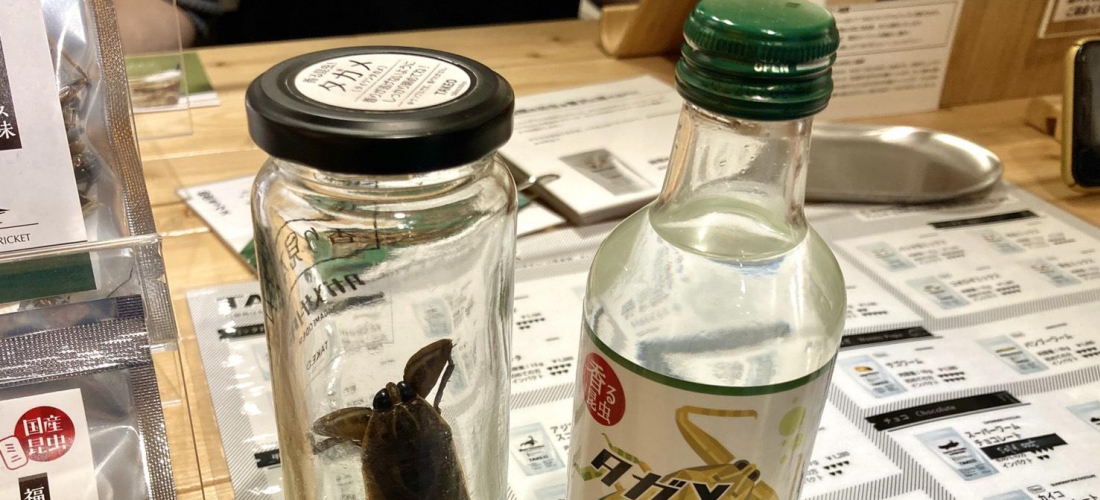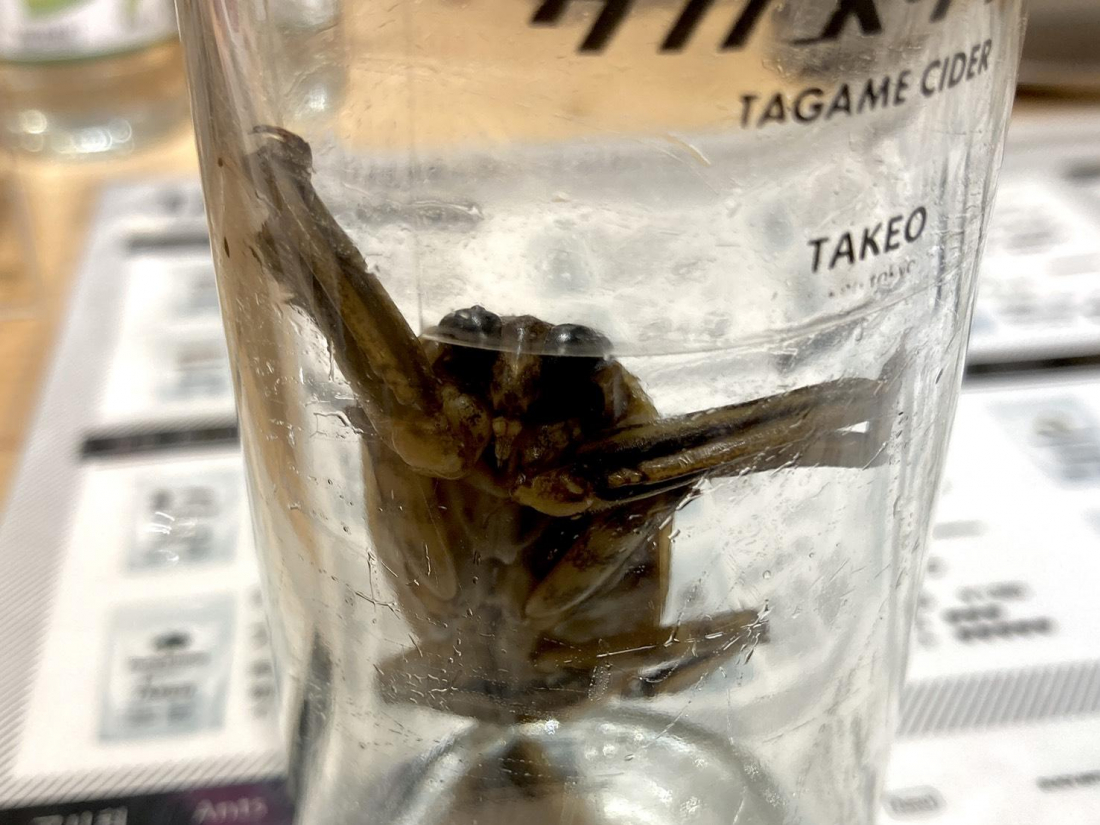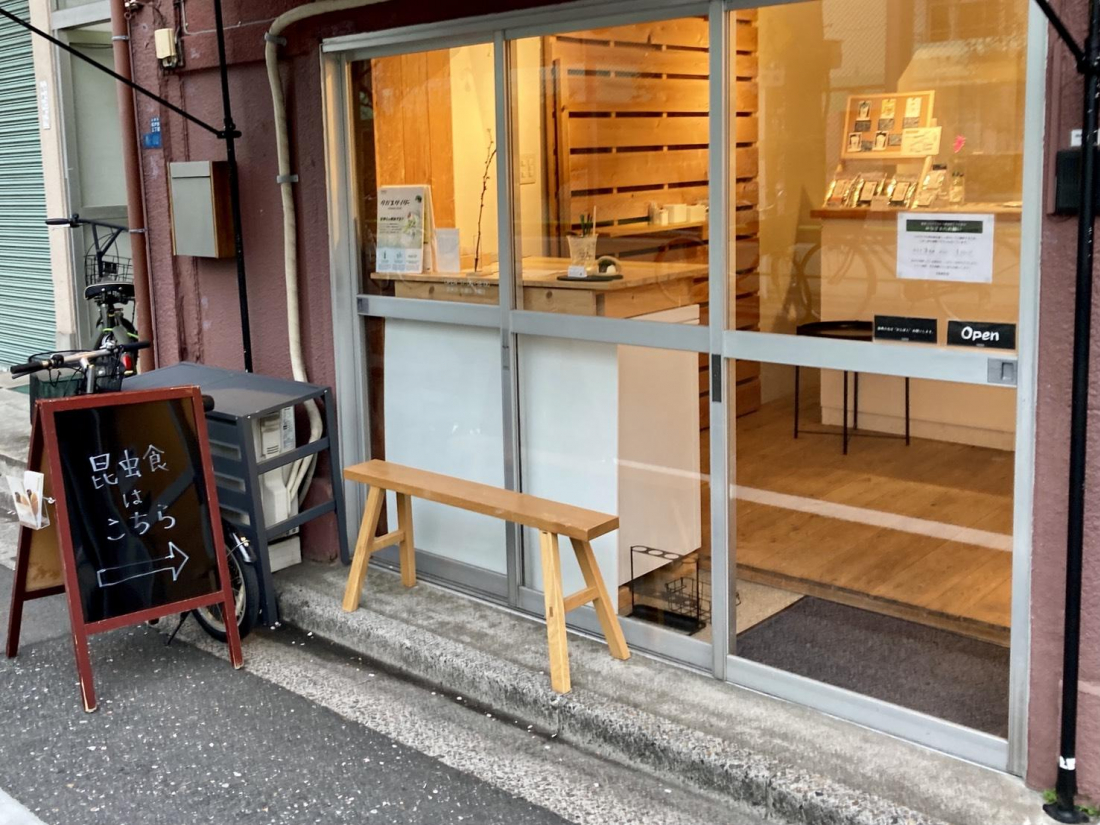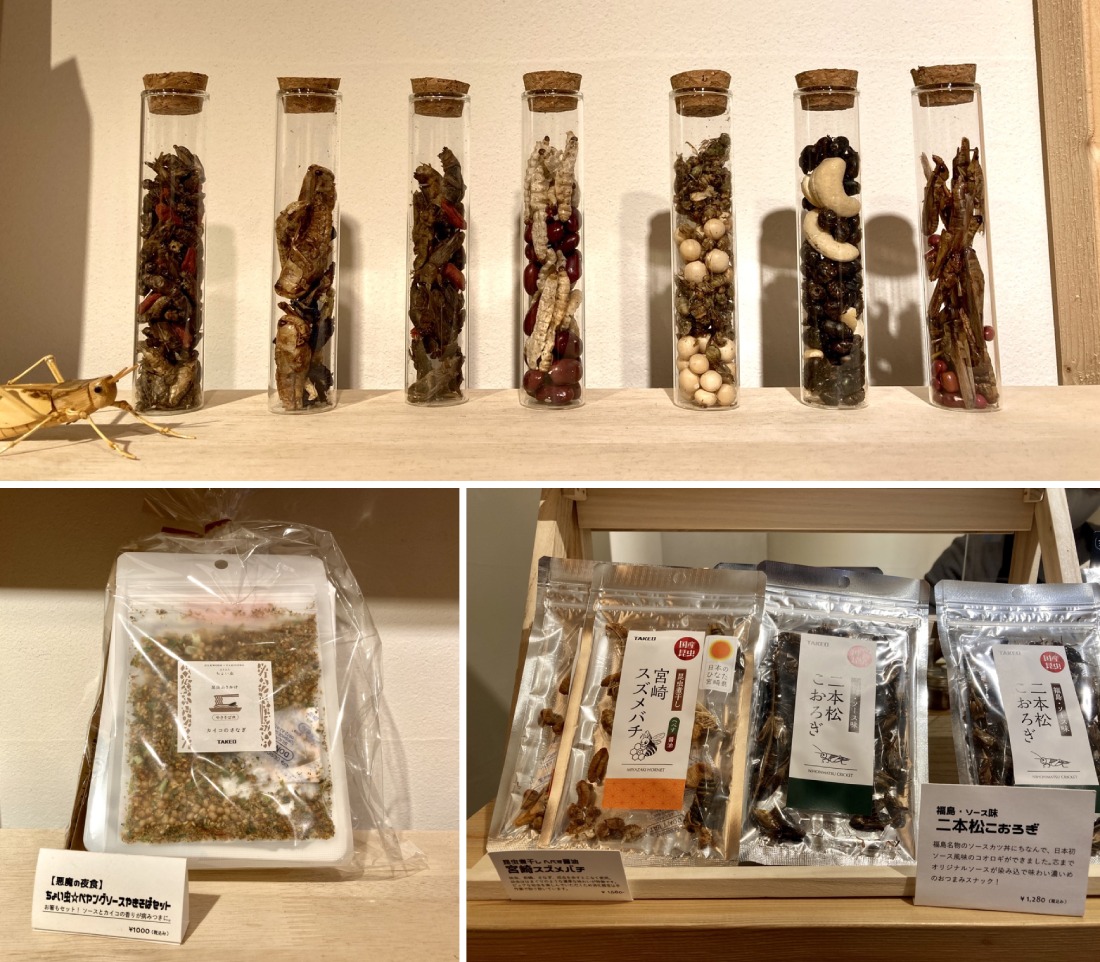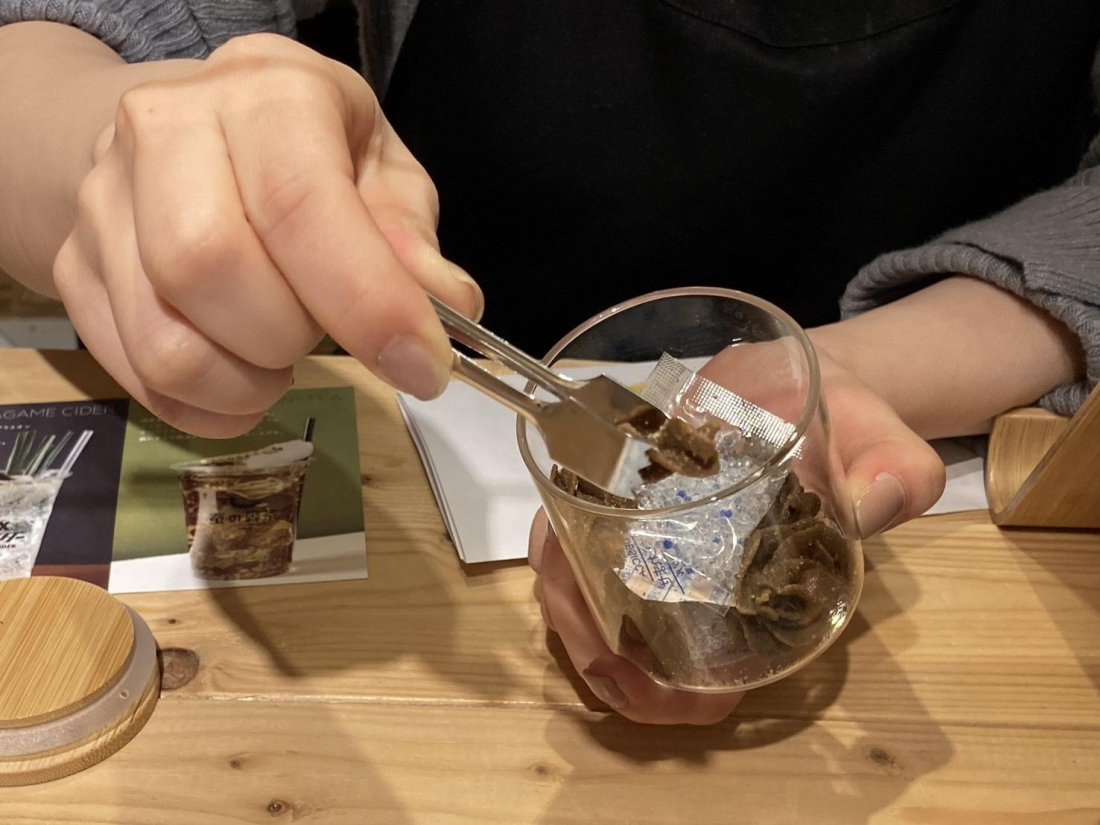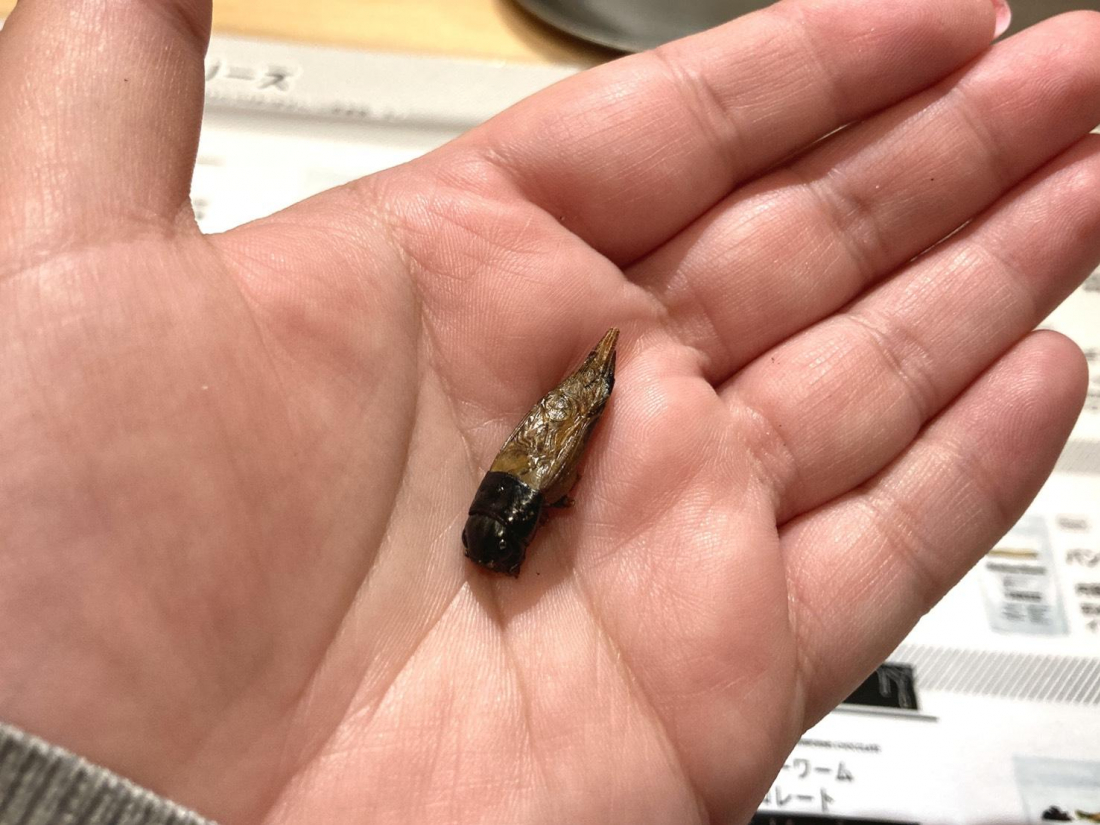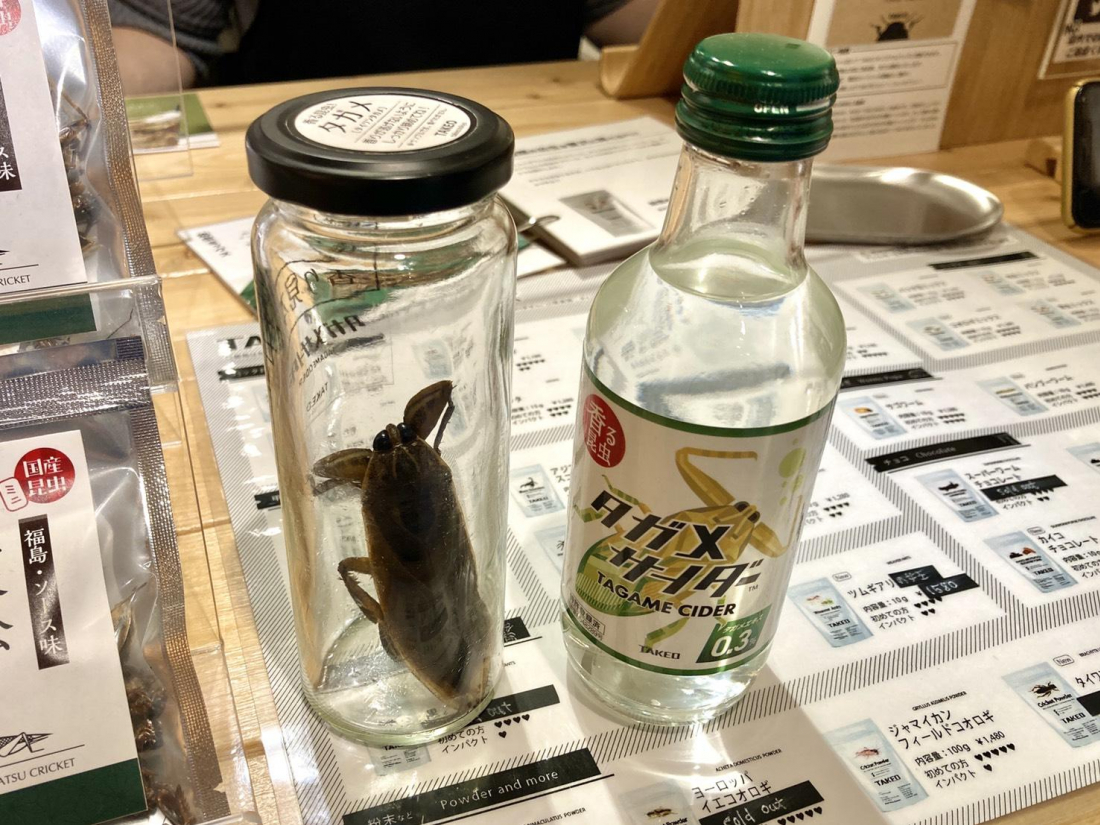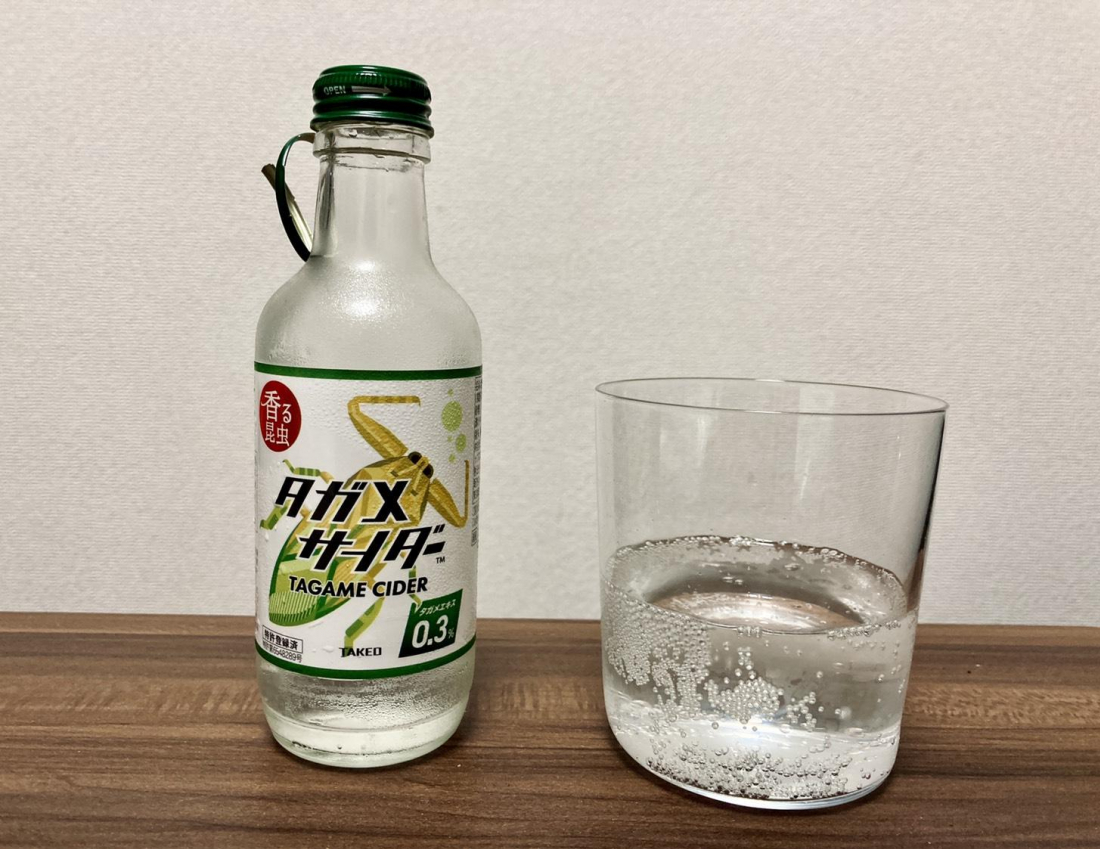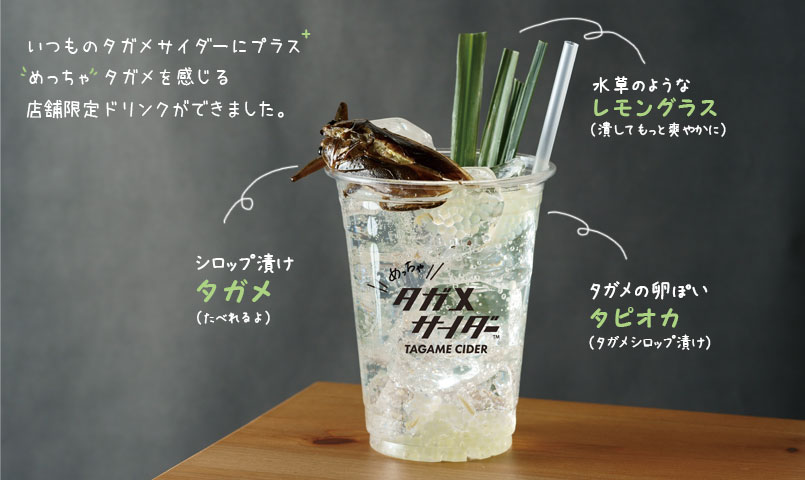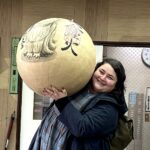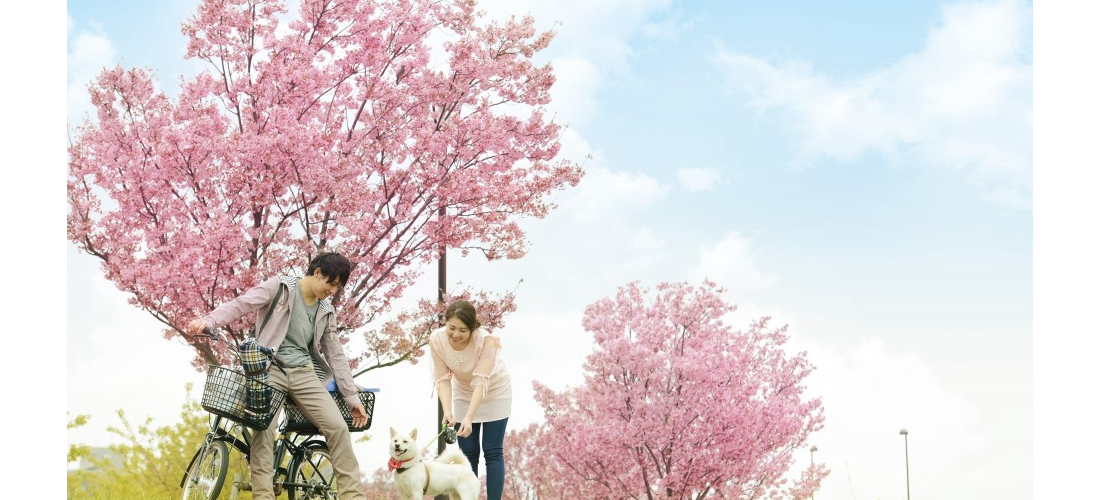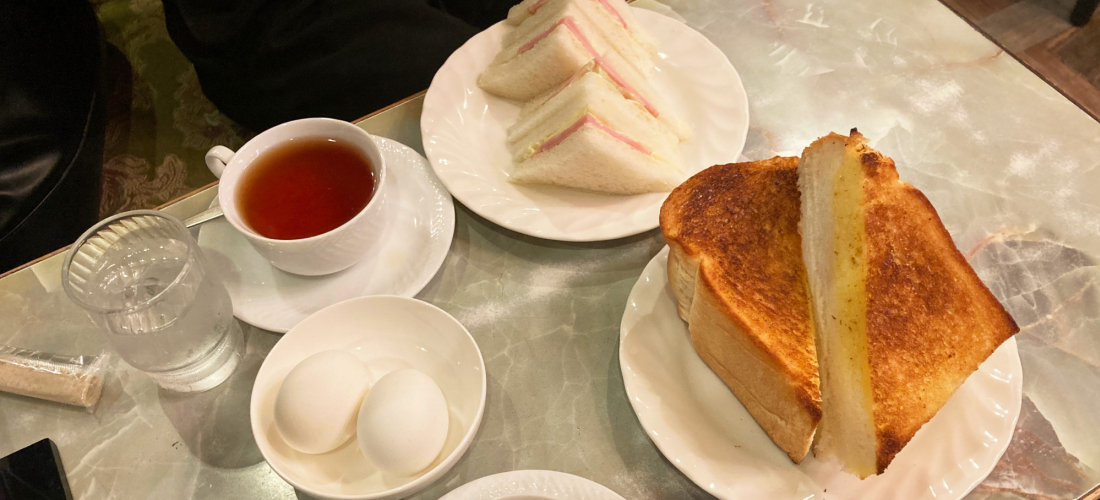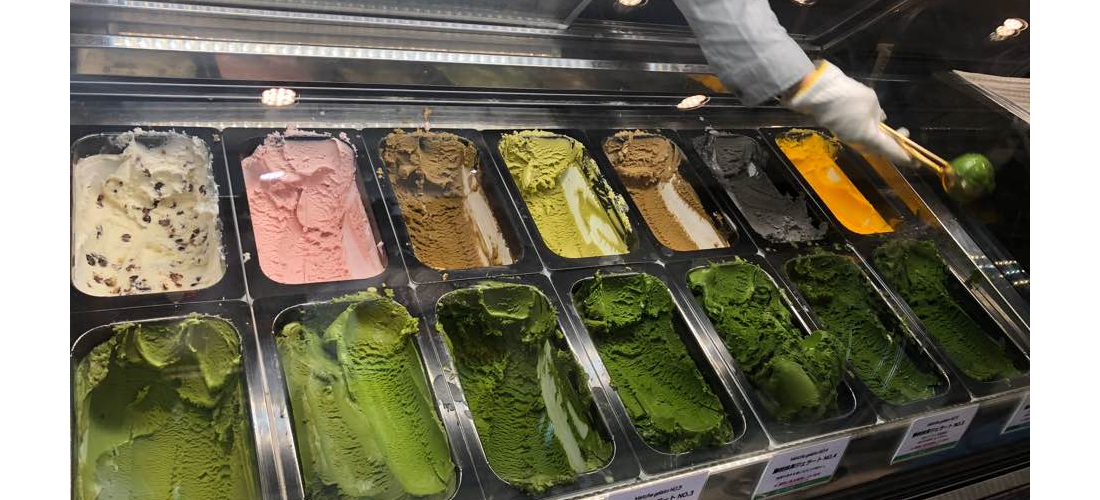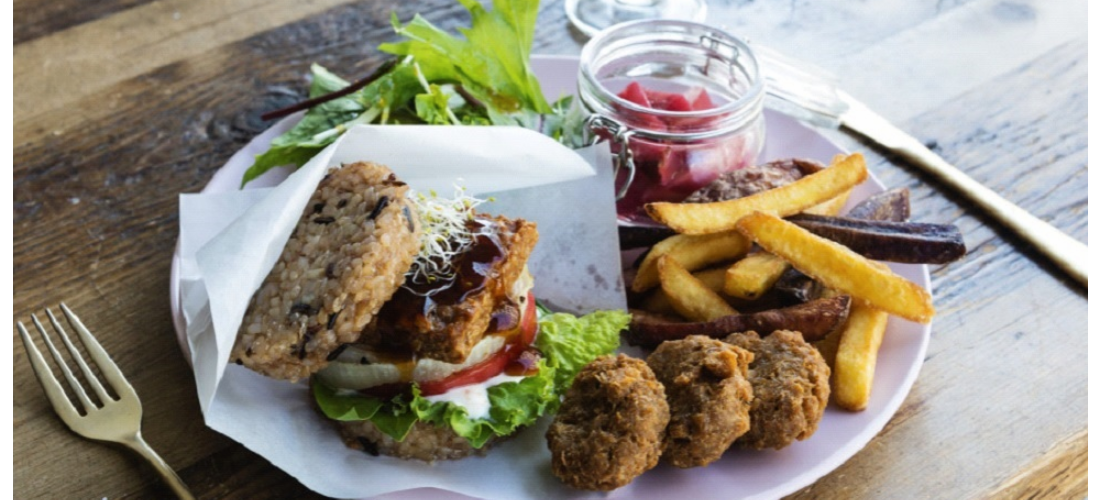For a bite of cricket or a sip of giant water bug juice, there’s nowhere better than this spot between Asakusa and Ueno.
Insect-eating, called entomophagy in English or konchushoku (昆虫食) in Japanese, has long been a part of Japanese food culture. From bee larvae (ハチの幼虫) to grasshoppers (イナゴ), insects were once a part of the everyday diet for many people across Japan, and this bug-eating culture still hangs on in small pockets of rural Japan to this day. In recent years, however, a new wave of entomophagy has appeared in Japan alongside those local traditions, bringing with it the roasted insects popular as street food in Southeast Asia, the cricket meal that has become trendy in the West, and plenty more. Konchushoku is growing in popularity once again across Japan.
At least, that's what I learned when I happened upon this sign in front of a tiny Tokyo storefront, tucked away down a side street midway between Asakusa and Ueno. Lured in by the sign proclaiming "entomophagy this way," I rang the doorbell, and a friendly shopkeeper appeared at the entrance to let me in. Inside was an unexpected insect-eater's paradise, which I found out was actually the storefront of Japanese entomophagy specialty shop Takeo (which does much of its business online).
The store is small, but the displays are stocked with insect-edibles of all kinds. Takeo sells bugs that are roasted, dried, fried, and more, and flavored with seasonings of all kinds (or nothing at all, if you want that pure insect flavor). Little jars and plastic bags show off their contents: samplers of various species of cricket, dried Miyazaki hornets, insects flavored with the sauce used in Fukushima's famous katsu-don sauce, the list goes on. They even sell a set that comes with a container of Peyoung instant yakisoba, and a special topping pack made with silkworm pupae!
Apparently the grown insects are best eaten crunchy, as-is, but some of the larvae will plump back up when submerged in a little hot water, making for a new and different mouthfeel. You can then drink the remaining water as a sort of insect broth, which also came highly recommended.
Curious customers are clearly a common occurrence in the shop, and shopkeeper Michiko quickly started offering samples of some of their more popular products. The first one was this dried pasta snack they call "Hard Bug," similar to snacks you might see in an average Japanese convenience store, except that these are made with 20% cricket. The morsels were a little harder than your average savory snack, giving them some serious crunch, but the flavor was altogether fairly mild and appealing. (If you're reading this but also terrified of eating insects, you'd never have any idea these snacks contained crickets, so they're a good place to start!)
Next came the real deal: katsu-don sauce cricket. After I explained to Michiko that bugs seemed okay to me, but I was terrified of the little legs getting stuck in my throat, she kindly picked out a small one… without its legs. Apparently the fragile limbs fall off of the cooked crickets pretty frequently.
So I put it in my mouth…
…and really, it was perfectly tasty. Without the horror of tiny legs, I had no trouble with the light, crunchy cricket texture, and the flavor was gently savory (with no strange "buggy" flavors or unappealing aftertaste). I suspect most people probably wouldn't even have an issue with the legs.
The next real challenge was Takeo's Tagame Cider. Tagame (タガメ), AKA Lethocerus deyrollei, is a species of large, predatory, nocturnal giant water bug found in Japan and throughout Asia. Cider is a kind of Japanese soft drink, with a bubblegum-esque flavor similar to ramune. And tagame cider is a soda made with 0.3% tagame extract.
After I expressed my interest in this unique drink, Michiko produced a jar containing a tagame preserved in syrup, and told me to give it a sniff. It turns out, tagame actually have a strong, distinct smell, and that scent is surprisingly similar to green apple candy. Easily convinced, I bought a bottle of the cider to take home.
After chilling the bottle at home, I couldn't resist anymore, and I finally took a sip of the tagame cider. This actual bug juice really does taste a lot like green apple candy! The drink was very sweet, as cider tends to be, with a fresh fruity flavor that you would never expect to come from a bug.
Takeo has a huge selection of different insect snacks on their website, but the storefront offers a few specialty items that you can eat at their little counter, or get to go. Next time I visit, I might have to pluck up some courage and go for their "Meccha Tagame Cider" specialty drink, which creates a natural scene in a cup. Stalks of aromatic lemongrass stand in for the reeds of the bugs' natural habitat, and small translucent pearls of tapioca soaked in tagame syrup resemble clusters of tagame eggs. Finally, of course, a whole syrup-soaked giant water bug sits atop the drink, like the cherry on a sundae. Yes, you can eat it.
Or maybe I'll get their monaka ice cream sandwich with sweet soy-sauce crickets instead.
To see what products Takeo has to offer, take a look at their official website, or just head directly to the storefront and ring the doorbell. For more info and updates from Japan, check Japankuru for new articles, and don't forget to follow us on twitter, instagram, and facebook!
Details
NAME:Takeo Entomophagy Specialty Shop
ACCESS:Inaricho Station, Asakusa Station, Ueno Station
Half a lifetime ago I came to Japan for a semester abroad... and I never left. I guess I really like the place! I spent my first few years in Japan living in the middle of nowhere, so I'd love to hear your Tokyo recommendations via Japankuru's social media accounts!
COMMENT
FEATURED MEDIA
VIEW MORE 
A New Tokyo Animal Destination: Relax & Learn About the World’s Animals in Japan
#pr #japankuru #anitouch #anitouchtokyodome #capybara #capybaracafe #animalcafe #tokyotrip #japantrip #카피바라 #애니터치 #아이와가볼만한곳 #도쿄여행 #가족여행 #東京旅遊 #東京親子景點 #日本動物互動體驗 #水豚泡澡 #東京巨蛋城 #เที่ยวญี่ปุ่น2025 #ที่เที่ยวครอบครัว #สวนสัตว์ในร่ม #TokyoDomeCity #anitouchtokyodome

Shohei Ohtani Collab Developed Products & Other Japanese Drugstore Recommendations From Kowa
#pr #japankuru
#kowa #syncronkowa #japanshopping #preworkout #postworkout #tokyoshopping #japantrip #일본쇼핑 #일본이온음료 #오타니 #오타니쇼헤이 #코와 #興和 #日本必買 #日本旅遊 #運動補充能量 #運動飲品 #ช้อปปิ้งญี่ปุ่น #เครื่องดื่มออกกำลังกาย #นักกีฬา #ผลิตภัณฑ์ญี่ปุ่น #อาหารเสริมญี่ปุ่น

도쿄 근교 당일치기 여행 추천! 작은 에도라 불리는 ‘가와고에’
세이부 ‘가와고에 패스(디지털)’ 하나면 편리하게 이동 + 가성비까지 완벽하게! 필름카메라 감성 가득한 레트로 거리 길거리 먹방부터 귀여움 끝판왕 핫플&포토 스폿까지 총집합!
Looking for day trips from Tokyo? Try Kawagoe, AKA Little Edo!
Use the SEIBU KAWAGOE PASS (Digital) for easy, affordable transportation!
Check out the historic streets of Kawagoe for some great street food and plenty of picturesque retro photo ops.
#pr #japankuru #도쿄근교여행 #가와고에 #가와고에패스 #세이부패스 #기모노체험 #가와고에여행 #도쿄여행코스 #도쿄근교당일치기 #세이부가와고에패스
#tokyotrip #kawagoe #tokyodaytrip #seibukawagoepass #kimono #japantrip

Hirakata Park, Osaka: Enjoy the Classic Japanese Theme Park Experience!
#pr #japankuru #hirakatapark #amusementpark #japantrip #osakatrip #familytrip #rollercoaster #retrôvibes #枚方公園 #大阪旅遊 #關西私房景點 #日本親子旅行 #日本遊樂園 #木造雲霄飛車 #히라카타파크 #สวนสนุกฮิราคาตะพาร์ค

🍵Love Matcha? Upgrade Your Matcha Experience With Tsujiri!
・160년 전통 일본 말차 브랜드 츠지리에서 말차 덕후들이 픽한 인기템만 골라봤어요
・抹茶控的天堂!甜點、餅乾、飲品一次滿足,連伴手禮都幫你列好清單了
・ส่องมัทฉะสุดฮิต พร้อมพาเที่ยวร้านดังในอุจิ เกียวโต
#pr #japankuru #matcha #matchalover #uji #kyoto #japantrip #ujimatcha #matchalatte #matchasweets #tsujiri #말차 #말차덕후 #츠지리 #교토여행 #말차라떼 #辻利抹茶 #抹茶控 #日本抹茶 #宇治 #宇治抹茶 #日本伴手禮 #抹茶拿鐵 #抹茶甜點 #มัทฉะ #ของฝากญี่ปุ่น #ชาเขียวญี่ปุ่น #ซึจิริ #เกียวโต

・What Is Nenaito? And How Does This Sleep Care Supplement Work?
・你的睡眠保健品——認識「睡眠茶氨酸錠」
・수면 케어 서플리먼트 ‘네나이토’란?
・ผลิตภัณฑ์เสริมอาหารดูแลการนอน “Nenaito(ネナイト)” คืออะไร?
#pr #japankuru #sleepcare #japanshopping #nenaito #sleepsupplement #asahi #睡眠茶氨酸錠 #睡眠保健 #朝日 #l茶胺酸 #日本藥妝 #日本必買 #일본쇼핑 #수면 #건강하자 #네나이토 #일본영양제 #อาหารเสริมญี่ปุ่น #ช้อปปิ้งญี่ปุ่น #ร้านขายยาญี่ปุ่น #ดูแลตัวเองก่อนนอน #อาซาฮิ

Japanese Drugstore Must-Buys! Essential Items from Hisamitsu® Pharmaceutical
#PR #japankuru #hisamitsu #salonpas #feitas #hisamitsupharmaceutical #japanshopping #tokyoshopping #traveltips #japanhaul #japantrip #japantravel

Whether you grew up with Dragon Ball or you just fell in love with Dragon Ball DAIMA, you'll like the newest JINS collab. Shop this limited-edition Dragon Ball accessory collection to find some of the best Dragon Ball merchandise in Japan!
>> Find out more at Japankuru.com! (link in bio)
#japankuru #dragonball #dragonballdaima #animecollab #japanshopping #jins #japaneseglasses #japantravel #animemerch #pr

This month, Japankuru teamed up with @official_korekoko to invite three influencers (originally from Thailand, China, and Taiwan) on a trip to Yokohama. Check out the article (in Chinese) on Japankuru.com for all of their travel tips and photography hints - and look forward to more cool collaborations coming soon!
【橫濱夜散策 x 教你怎麼拍出網美照 📸✨】
每次來日本玩,是不是都會先找旅日網紅的推薦清單?
這次,我們邀請擁有日本豐富旅遊經驗的🇹🇭泰國、🇨🇳中國、🇹🇼台灣網紅,帶你走進夜晚的橫濱!從玩樂路線到拍照技巧,教你怎麼拍出最美的夜景照。那些熟悉的景點,換個視角說不定會有新發現~快跟他們一起出發吧!
#japankuru #橫濱紅磚倉庫 #汽車道 #中華街 #yokohama #japankuru #橫濱紅磚倉庫 #汽車道 #中華街 #yokohama #yokohamaredbrickwarehouse #yokohamachinatown

If you’re a fan of Vivienne Westwood's Japanese designs, and you’re looking forward to shopping in Harajuku this summer, we’ve got important news for you. Vivienne Westwood RED LABEL Laforet Harajuku is now closed for renovations - but the grand reopening is scheduled for July!
>> Find out more at Japankuru.com! (link in bio)
#japankuru #viviennewestwood #harajuku #omotesando #viviennewestwoodredlabel #viviennewestwoodjapan #비비안웨스트우드 #오모테산도 #하라주쿠 #日本購物 #薇薇安魏斯伍德 #日本時尚 #原宿 #表參道 #japantrip #japanshopping #pr

Ready to see TeamLab in Kyoto!? At TeamLab Biovortex Kyoto, the collective is taking their acclaimed immersive art and bringing it to Japan's ancient capital. We can't wait to see it for ourselves this autumn!
>> Find out more at Japankuru.com! (link in bio)
#japankuru #teamlab #teamlabbiovortex #kyoto #kyototrip #japantravel #artnews
Photos courtesy of teamLab, Exhibition view of teamLab Biovortex Kyoto, 2025, Kyoto ® teamLab, courtesy Pace Gallery

Japanese Makeup Shopping • A Trip to Kamakura & Enoshima With Canmake’s Cool-Toned Summer Makeup
#pr #canmake #enoshima #enoden #에노시마 #캔메이크 #japanesemakeup #japanesecosmetics

⚔️The Robot Restaurant is gone, but the Samurai Restaurant is here to take its place. Check it out, and don't forget your coupon!
🍣신주쿠의 명소 로봇 레스토랑이 사무라이 레스토랑으로 부활! 절찬 쿠폰 발급중
💃18歲以上才能入場的歌舞秀,和你想的不一樣!拿好優惠券去看看~
#tokyo #shinjuku #samurairestaurant #robotrestaurant #tokyotrip #도쿄여행 #신주쿠 #사무라이레스토랑 #이색체험 #할인이벤트 #歌舞伎町 #東京景點 #武士餐廳 #日本表演 #日本文化體驗 #japankuru #japantrip #japantravel #japanlovers #japan_of_insta

Japanese appliance & electronics shopping with our KOJIMA x BicCamera coupon!
用JAPANKURU的KOJIMA x BicCamera優惠券買這些正好❤️
코지마 x 빅 카메라 쿠폰으로 일본 가전 제품 쇼핑하기
#pr #japankuru #japanshopping #kojima #biccamera #japaneseskincare #yaman #dji #osmopocket3 #skincaredevice #日本購物 #美容儀 #相機 #雅萌 #日本家電 #일본여행 #면세 #여행꿀팁 #일본쇼핑리스트 #쿠폰 #일본쇼핑 #일본브랜드 #할인 #코지마 #빅카메라 #japankurucoupon

